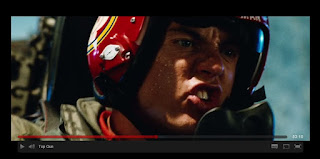I was first introduced to the concept of the Midpoint Scene by James Scott Bell in Write Your Novel From The Middle. That book revolutionized my understanding of story structure, and I've developed stories with the Midpoint in mind ever since.
K.M. Weiland also talks about the Midpoint in her brilliant series on story structure. Her idea of the Midpoint is fairly similar to JSB's: a relatively calm moment of reflection (a Mirror Scene) where the protagonist reflects on his or her goals, motivations, or attitudes, and realizes--on some level--that something needs to change.
Since I encountered this idea, whenever I watch movies and read books, I'm always on the lookout for the magic Midpoint. I ask my wife to bring up the progress bar whenever we watch something on Netflix, and once I'm more than halfway through a book, I go back and try to pinpoint the exact Midpoint scene.
And I've discovered something that some people might disagree with. The Midpoint and the Mirror Scene (or Moment of Grace) are not always in the exact middle. In fact, there's a pretty big margin of error when it comes to the placement of the Mirror Scene. It's almost always there in some form, but sometimes it comes long after the halfway mark.
I tend to favor more action-oriented stories. Not necessarily "action" movies, but anything that falls under speculative fiction, action adventure, or hard-hitting drama. And in those stories, what does tend to occupy the exact middle of the story is an action-oriented event on par with Turning Point One. Then, once it's over, the Mirror Scene occurs.
From what I've seen, the middle 10-15% of the story consists of an action-oriented scene where something important changes, and a follow-up scene where the character reflects on those events, and these reflections lead to an important realization.
From what I've seen, the middle 10-15% of the story consists of an action-oriented scene where something important changes, and a follow-up scene where the character reflects on those events, and these reflections lead to an important realization.
Once I read Weiland's series on Scene Structure (Scene and Sequel), I realized that what happens in the middle of a story is not so much a specific kind of scene, as a specific sequence of scenes (for more on this, read my take on scene structure).
The short version is that the middle 10-15% of a well-structured story should consist of a scene or scenes of action that revolves around the central conflict, and a follow-up reaction scene where the main character realizes something important that pushes them into conscious competence.
In Harry Potter and the Deathly Hallows, the middle chunk of the book consists of three related chapters. In "Xenophilius Lovegood", Harry, Ron, and Hermione meet Luna's eccentric father, who, in a state of panic over his daughter's kidnapping, attempts to turn Harry and co in to the authorities. In response to their questioning, and as a means of stalling them, Xenophilius tells them about the Deathly Hallows.
The next chapter, "The Tale of the Three Brothers", begins with a detailed account of the Hallows which quickly devolves into a chaotic escape from the Snatchers. It's some of the best action in the book, and it constitutes the action phase of the Midpoint Sequence.
The third chapter, "The Deathly Hallows" primarily concerns itself with Harry's increasing obsession with the tale of the Hallows, and his gradual realization that they are the key to defeating Voldemort. Harry spends the bulk of the chapter in reflection, touching on a number of issues that are at the core of the novel's conflict. Thus, it constitutes the reaction phase of the Midpoint Sequence.
In my stories, I always try to find a Midpoint Sequence which contains game-changing action, and a realization-fueled reaction. And this two-part structure is what I think is really crucial in the middle of a story. So long as this sequence begins no later than the 50% mark, and ends no sooner, I think it will feel properly structured to the reader.
What the Midpoint Sequence consists of is open-ended, but its placement makes it one of the non-negotiable structural points of any story. It pushes the protagonist from conscious incompetence to conscious competence, and in the process highlights the key issue at the heart of the story's argument.
Next, we'll look at Act Three.











No comments:
Post a Comment